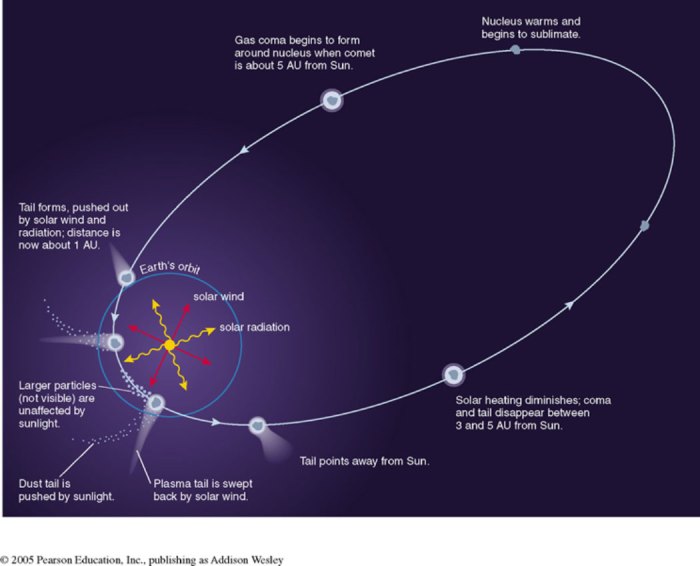Comets with extremely elliptical orbits like hyakutake and hale bopp – Comets with extremely elliptical orbits, like Hyakutake and Hale-Bopp, captivate astronomers and the public alike. Their unique trajectories and physical characteristics offer valuable insights into the formation and evolution of our solar system. This article explores the distinguishing features, origins, scientific significance, and potential impact of these celestial wanderers.
1. Physical Characteristics of Comets with Extremely Elliptical Orbits

Comets with highly elliptical orbits possess distinct physical features that set them apart from other comets. Their orbits, characterized by extreme eccentricity, deviate significantly from circular paths. These comets tend to have elongated and elongated nuclei, often composed of a mixture of ice, dust, and organic compounds.
Notable examples include Hyakutake and Hale-Bopp, which exhibited highly elliptical orbits and displayed prominent tails during their respective apparitions.
Orbital Eccentricity
The orbital eccentricity of a comet is a measure of how elongated its orbit is. Eccentricity values range from 0 to 1, with 0 representing a circular orbit and 1 representing a parabolic or hyperbolic orbit. Comets with extremely elliptical orbits have eccentricity values close to 1, indicating that their orbits are highly elongated.
Size and Composition
The size and composition of comets with elliptical orbits vary, but they generally have smaller nuclei compared to short-period comets. Their nuclei typically range in size from a few kilometers to tens of kilometers. The composition of these comets is predominantly icy, with significant amounts of dust and organic compounds.
As they approach the Sun, the icy material sublimates, forming a coma and tail.
2. Formation and Origin of Comets with Elliptical Orbits

The formation and origin of comets with elliptical orbits remain subjects of ongoing research. One prevailing theory suggests that these comets originate from the Oort Cloud, a vast reservoir of icy bodies located at the outer fringes of the solar system.
Gravitational interactions with other objects, such as passing stars or giant planets, can perturb the orbits of these comets, sending them into the inner solar system.
Oort Cloud Origin
The Oort Cloud is believed to contain trillions of icy bodies, remnants from the early formation of the solar system. These bodies are thought to be composed primarily of water ice, methane, ammonia, and other volatiles. Gravitational interactions with passing stars or giant planets can dislodge these objects from the Oort Cloud, propelling them into more eccentric orbits.
Gravitational Interactions
Gravitational interactions play a crucial role in shaping the orbits of comets with elliptical orbits. Close encounters with giant planets, such as Jupiter and Saturn, can significantly alter their trajectories. These interactions can either increase or decrease the eccentricity of the comet’s orbit, depending on the specific encounter conditions.
3. Observational History and Scientific Significance

Comets with elliptical orbits have been observed throughout history, with notable examples including Hyakutake and Hale-Bopp. These comets have provided valuable insights into the composition and dynamics of the outer solar system. Their study has contributed to our understanding of the formation and evolution of the solar system, as well as the potential hazards posed by comets.
Historical Observations
Early observations of comets with elliptical orbits date back to ancient times. In 1996, Comet Hyakutake became one of the brightest comets of the 20th century, displaying a prominent tail visible to the naked eye. Similarly, Comet Hale-Bopp, which appeared in 1997, was notable for its long duration of visibility and its spectacular tail.
Scientific Significance
Comets with elliptical orbits serve as probes of the early solar system. Their pristine composition, preserved since their formation, provides valuable information about the conditions and processes that existed during the solar system’s infancy. Additionally, these comets can provide insights into the potential hazards posed by cometary impacts, helping us develop strategies to mitigate their risks.
4. Impact on Earth and Other Celestial Bodies

Comets with elliptical orbits have the potential to impact Earth and other celestial bodies. While direct impacts are relatively rare, the consequences of such events can be devastating. The impact of Comet Shoemaker-Levy 9 with Jupiter in 1994 provided a glimpse of the potential destructive power of comets.
Impact Risks, Comets with extremely elliptical orbits like hyakutake and hale bopp
The risk of a cometary impact on Earth is assessed based on factors such as the comet’s orbit, size, and composition. Near-Earth objects (NEOs), including comets, are monitored by astronomers to identify potential impact threats. Mitigation strategies, such as deflection or disruption techniques, are being developed to address the potential risks posed by these objects.
Historical Impacts
There is evidence to suggest that comets have impacted Earth in the past, contributing to mass extinctions and other significant geological events. The Chicxulub impact crater, located in the Gulf of Mexico, is believed to have been caused by a comet or asteroid impact approximately 66 million years ago, leading to the extinction of the dinosaurs.
Key Questions Answered: Comets With Extremely Elliptical Orbits Like Hyakutake And Hale Bopp
What are the key physical characteristics of comets with extremely elliptical orbits?
These comets exhibit high orbital eccentricity, meaning their orbits are highly elongated and deviate significantly from a circular path.
How do comets like Hyakutake and Hale-Bopp originate?
Theories suggest they may originate from the Oort Cloud, a vast reservoir of icy bodies located at the outskirts of our solar system.
What scientific significance do these comets hold?
They serve as probes of the early solar system, providing insights into the composition and dynamics of its primordial environment.